








After the second night in the field center (which the ghost tour lady from the night before told us was haunted), we left to continue with the trip. Though not before we left our mark on the much-graffitied walls (below, left).
The day was mostly focused on our academics (this field trip, unlike Perth, actually relates to our class). At the end of this class, we have to submit two papers relating to ecotourism and conservation. Basically there’s a catch-22 with declaring something a protected area. As soon as a new protected area is announced, more people hear about it and want to see it, thus making it harder to protect. So, we went to a few places to see this dynamic in action.
The first place was called Robertson’s Bridge, and it was a random rainforest smack in the middle of a normal forest (above). It is a protected area, but the area around it is not protected. So, it has been heavily logged, right up to the border of the rainforest. This caused a forest fire to spread to the rainforest, which is usually too wet to burn. We made another stop at a beach where people had planted pine trees, ruining the natural ecosystem there. We did our part and pulled up as many pine trees as we could find.
Then we went to Mayfield Bay, a really popular camping area (beach, above). It was an example of a place where sustainable efforts were working and had cleaned up the beach considerably in the last 5 years. Also at Mayfield Bay was a convict-built bridge with arches that made for a cool picture (above). We finally made it to our hostel in Coles Bay, where we enjoyed a lovely sunset (above).
Yesterday we went to Wineglass Bay, which recently was named one of the top 10 most beautiful beaches in the world (above me). We hiked up to a lookout point for fantastic views of the Bay, and couldn’t resist taking lots of pictures of ourselves (me, Eric, above). Framing the bay were these really cool rocks and cliffs (above). It was pretty awesome.
After a long drive, we returned to Hobart. It was a fantastic trip, but I was glad to be home.
















































